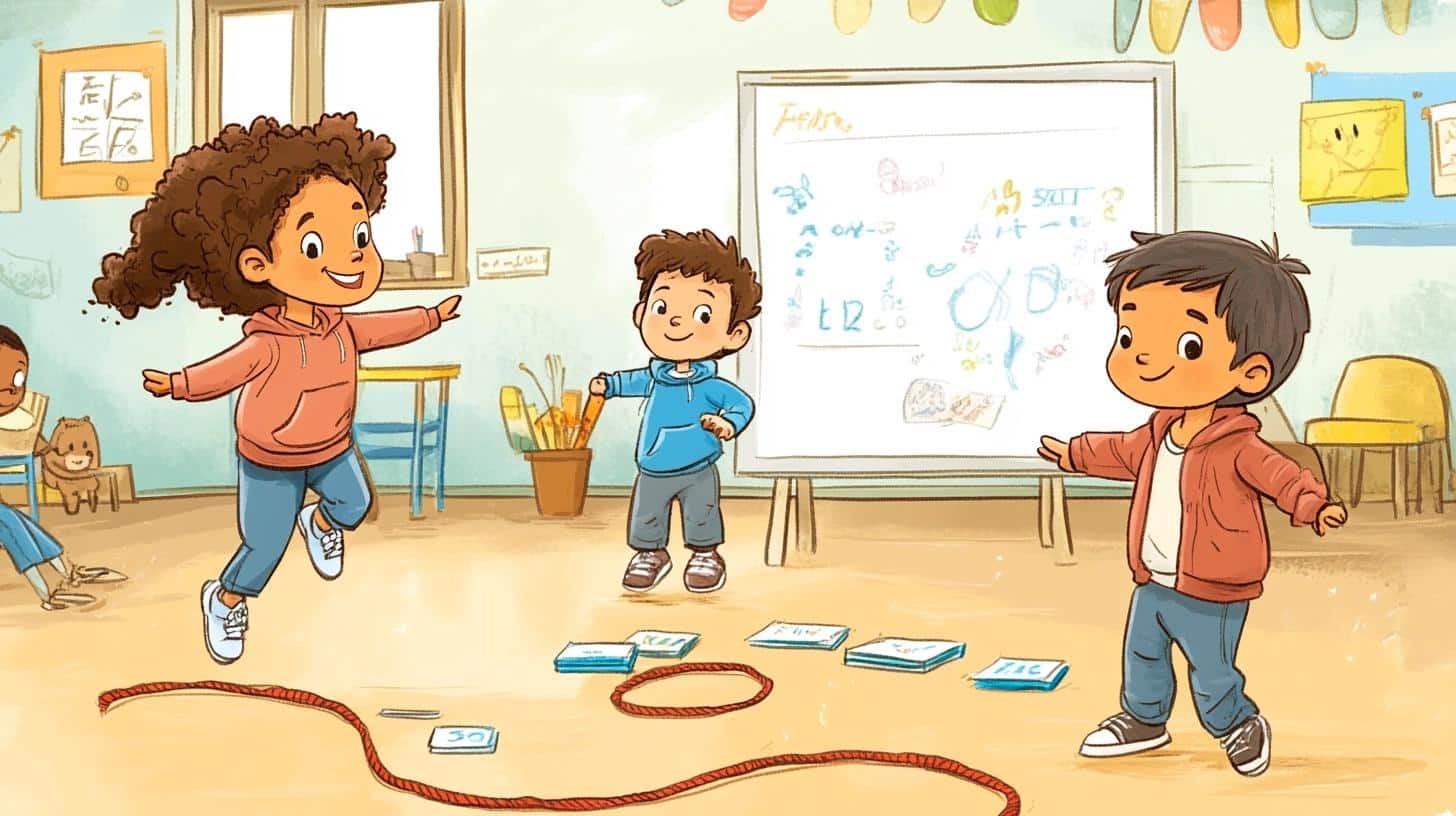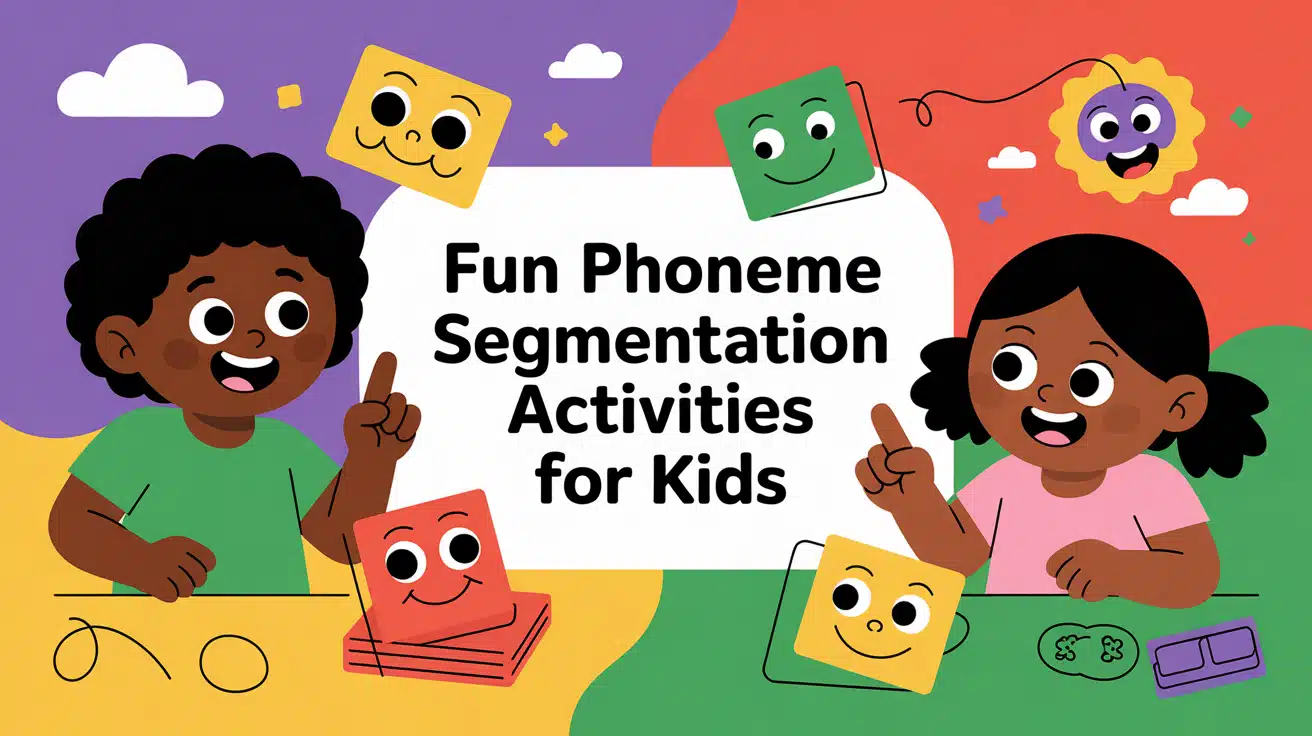See how kids learn to read by sounding out words? That’s phoneme segmentation in play.
It’s when a child hears a word like “dog” and breaks it into the sounds /d/ /o/ /g/. This helps them understand how letters and sounds work together.
Learning this skill early helps kids become better readers and writers. But let’s be real—just sitting and listening won’t cut it. Kids learn best when they do things. That’s why fun, hands-on phoneme segmentation activities make a big difference.
In this blog, you’ll find smart and simple activities to help kids build this skill. You’ll get ideas that are easy to use, keep kids busy, and actually help them learn.
Phoneme Segmentation Overview
Phoneme segmentation means breaking a word into its separate sounds. For example, if a child hears the word “cat” and says the sounds /c/ /a/ /t/, that’s phoneme segmentation.
This skill is super important when kids are learning to read. It helps them understand that words are made up of sounds, and each sound connects to a letter. Once kids get this, they can sound out and read new words more easily.
When kids learn how to break words into sounds, they also get better at spelling. They can match the sounds they hear to the letters they need. It’s like a puzzle where the sounds fit into the right letter spots.
Reading starts with small steps. First, kids learn that sentences are made of words. Then they learn that words have syllables. Finally, they figure out that syllables are made of single sounds. Phoneme segmentation is the final and most important step.
Kids who practice this often build strong reading and writing skills. Teachers notice that kids who can break words into sounds have an easier time learning to read and write. They can also learn to spell better.
Some kids struggle with this skill, which can make reading difficult. That’s why it’s important to teach this skill early. With regular practice, it gets easier. Over time, their brains get better at hearing and using language.
Phoneme segmentation is a key part of reading. When kids improve at it, they also improve at reading and writing.
Types of Phoneme Segmentation Activities
There are many fun and simple ways to help kids break words into sounds. These phoneme segmentation activities keep learning active and playful while building strong reading and spelling skills. Here are some great ones to try.
Visual Activities

Visual activities help kids “see” sounds in words. These hands-on tools make it easier for children to break words apart and understand how sounds work.
1. Elkonin Boxes
Elkonin boxes are great for helping kids hear each sound in a word. You can draw 3 to 5 connected boxes on a strip of paper. Say a word like “cat.” Ask the child to repeat the word and push a small object (like a coin or button) into each box as they say each sound: /c/, /a/, /t/.
Once they get the hang of it, they can use letter tiles instead of objects. This helps them match sounds to letters. Kids understand sounds better when they can see and touch them.
Teachers often say this method works really well, even for students who struggle, because it uses sight, touch, and hearing all at once.
2. Bead Slide
The bead slide is simple to make and fun to use. Just slide 3 to 5 beads onto a string or pipe cleaner. Say a word out loud, like “fish.” The student repeats the word and slides one bead for each sound they hear: /f/, /i/, /sh/.
This helps kids pay attention to the order of sounds in a word. Moving the beads helps kids stay focused and makes the sounds feel real.
Kids who learn better with movement often do well with this activity. Many teachers see strong results because the beads help students remember what they’ve practiced.
3. Sound Scavenger Hunt
This one gets kids moving. Pick a sound, like /m/, and ask students to find things in the classroom that have that sound. It could be at the beginning, middle, or end of the word. When they find something, they say the word and break it into sounds.
Then they can share with the group. You can sort the objects by where the sound appears in each word. This turns a sound into something they can find, touch, and talk about.
It helps them listen better and become more aware of sounds all around them. Teachers say this activity often sticks with kids even after class.
4. Phoneme Sorting
This activity helps kids figure out where a sound shows up in a word. Use small toys or picture cards that match easy words. Draw three circles and label them “beginning,” “middle,” and “end.” Pick a sound, like /s/, and have students place each card in the right circle.
After placing each one, they should break the word into sounds. Talk about why the item belongs there. This helps kids think more deeply about how words work.
It’s not just about hearing sounds—it’s about thinking and explaining, too. This kind of practice helps kids read and spell better by paying close attention to sound patterns.
5. Picture Segmentation Cards
These cards use pictures to help students focus. Show a picture of something familiar—like a dog or sun. Ask the student to name it, then break the word into sounds while pointing to dots or boxes below the image. They can tap, clap, or move their fingers for each sound.
For older or more advanced students, use pictures of words with blends or tricky sounds. You can write the number of sounds on the back of each card so kids can check their answers.
These cards are easy to use with groups or one-on-one. They’re also good for home use. Many parents like them because they’re simple but very helpful.
Kinesthetic Activities

6. Sound Stomping
Sound stomping is loud, fun, and helps kids focus on each sound in a word. To play, say a word out loud. Then the student repeats the word, stomping their foot for every sound they hear.
If the word is dog, the student stomps three times: /d/, /o/, /g/. The stomping gives a strong body signal that makes each sound easier to feel and hear.
It’s great for energetic kids and works well with groups. You can even use it while standing in line or during brain breaks. It’s also helpful for students who need extra support with focus or memory.
7. Sound Marching
Marching while saying sounds helps kids stay in rhythm and say sounds clearly. Say a word, then have the child march in place or around the room, one step for each sound.
For the word hat, the student marches three steps: /h/, /a/, /t/. You can even add music or a beat to make it more fun.
Marching helps kids who need structure or have trouble sitting still. It also works well as a warm-up activity before reading or writing lessons.
8. Sound Squats
This is a high-energy activity that kids enjoy and remember. Say a word, and the student does a squat each time they say a sound.
For example, with the map, they do three squats: /m/, /a/, and/p/. This helps build body and sound awareness.
It’s great for kids who like to move or who need a way to release energy while still learning. You can turn it into a mini-workout or use it in small groups to practice sounds together.
9. Sound Toss
Sound toss turns sound practice into a partner game. You need a small ball or soft item. One person says a word, and each person takes turns tossing the ball and saying a sound.
For the word frog, the first person tosses the ball and says /f/, the second says /r/, and so on.
This builds listening skills, teamwork, and sound segmentation. It’s also great for one-on-one practice or small groups. You can even toss it into a basket for solo play.
10. Sound Slide
Use a toy car or any small object that can slide across a smooth surface. As the student slides the object, they say each sound slowly, one at a time.
For example, for red, they slide and say /r/, /e/, /d/. Then, they slide the object again, saying the whole word quickly to blend the sounds.
This helps students feel the smooth flow of sounds while still hearing each one clearly. It’s helpful for those just learning how to blend sounds.
Interactive and Game-Based Activities

These activities turn sound practice into games that kids actually want to play. They’re fun, easy to set up, and help students learn without even realizing it.
11. I Spy (Sound Version)
I Spy is a classic game, and when you change it to focus on sounds, it becomes a fun way to practice phonemic awareness. Instead of using the first letter of a word, students listen for all the sounds.
For example, say, “I spy something with the sounds /d/ /e/ /s/ /k/,” and they try to figure out that the word is desk. This helps kids hear each sound and blend them to make the word.
It feels like play, so students don’t feel stressed. Even kids who usually struggle enjoy this game. They get to take turns being the “spy,” which helps them practice both hearing and saying sounds.
You can play it with the whole class, in small groups, or even in the hallway while walking. Parents also like this version of the game and often use it during car rides or while waiting in line.
12. Robot Talking
Robot Talking is a silly and fun way to break words into sounds. Students pretend to talk like robots, saying each sound slowly and clearly.
For example, “sit down” becomes “/s/ /i/ /t/ … /d/ /ow/ /n/.” This playful voice helps kids focus on each sound one at a time. Teachers can give robot-style directions, and students try to figure out the command by blending the sounds.
Kids love this activity and often use it on their own while writing, especially when they need to figure out how to spell a word.
It’s simple, fun, and helps kids who are still learning English, too, since it makes sounds easier to hear and say.
13. Sound It Out Bingo
Sound It Out Bingo is a sound-matching game. Instead of using full words, the teacher says the word by splitting it into sounds, like “/b/ /u/ /s/” for bus. Students look at their bingo cards, which show pictures, and try to find the one that matches.
This game helps students hear and blend sounds to find the right word. It’s fun and easy to set up, and you can make it harder or easier based on your students’ needs.
It’s also a great way to review sounds and keep students engaged. Many teachers say kids learn better when they play games like this.
14. Phoneme Puzzle
Phoneme Puzzles turn words into puzzle pieces. Each piece stands for one sound. For the word cat, there are three pieces: /c/, /a/, and /t/. Kids put the pieces together, saying each sound as they go.
When they finish the puzzle, they say the full word. This helps them see and feel how sounds go together. Kids can also make their own puzzles, which makes them think more deeply about how words work.
This activity is great for centers, group work, or one-on-one time. You can make it harder with longer words or easier with short ones.
15. Word Demolition
Word Demolition is perfect for kids who like action. Start with a full word written on a whiteboard or built with blocks. Then have the child say each sound and take away one part at a time.
For stop, they say /s/ /t/ /o/ /p/ and remove a block or erase a letter with each sound. Kids love the idea of “breaking” a word.
It keeps their attention and makes the lesson exciting. This kind of learning sticks because it’s fun and hands-on. Even kids who don’t usually enjoy reading practice want to try this one. Teachers often add fun sound effects to make it even more engaging.
Games and Challenges

These games and challenges make learning sounds exciting and active. Kids stay focused, have fun, and build important reading skills at the same time. You can use them in small groups, with the whole class, or even one-on-one.
16. Sound Swap
Sound Swap is a word game where students change one sound in a word to make a new one. You start with a simple word like cat. Then you say, “Change the /c/ to /b/.” The student says the new word: bat.
This helps kids listen closely, think about each sound, and change it on purpose. Once they get the hang of it, you can make it harder by switching the middle or ending sounds. You can also use letter cards so kids can see and move the letters as they hear the sounds.
Teachers say this activity helps students with spelling and reading, and kids enjoy it because it feels like solving a word puzzle.
17. Segment and Build
In this activity, students use blocks, cubes, or letters to build a word one sound at a time. You say a word like ship, and they add a block while saying /sh/, then another for /i/, and another for /p/.
This shows how sounds come together to form words. It also helps students who like to move and touch things while they learn. Beginners can use shorter words, and more advanced students can build longer ones.
Some students even take this activity further by swapping blocks to make new words like shop or chip. It’s a hands-on way to learn how sounds and letters work together.
18. Rhyming and Segmenting Race
This fast game mixes rhyming and sound work. Split students into small teams. Each team gets a set of rhyming words, like cat, bat, hat, and rat. When you say “Go,” the teams race to break each word into its sounds.
They get points for doing it correctly and quickly. The rhyming part makes it easier for kids to hear the patterns, and the race keeps them excited and focused.
Students also learn from their teammates, which makes it great for groups. Some teachers ask students to create their own rhyme sets to make the game even more fun.
19. Phoneme Jump Rope
This activity mixes movement and sounds. Two people turn a jump rope while one student jumps. For each jump, they say one sound in a word. For dog, they jump three times: /d/, /o/, /g/.
The steady pace of jumping helps kids slow down and say each sound clearly. It’s fun, active and helps students who need to move during learning.
Teachers say it helps kids stay focused during reading time afterward. It can even be used during P.E. or at recess, giving more chances to practice sounds in a fun way.
20. Wheel of Sounds
This game works like a spinner show. Make a wheel with sounds or letters on it. A student spins the wheel, says the sound, and then gives a word that starts with that sound. You can make it harder by asking for words that end or have the sound in the middle.
The surprise of what sound they’ll get keeps kids excited. Teachers can make easier wheels for beginners and harder ones for older kids.
The spinner also helps kids connect sounds to letters, which is great for reading and spelling. To keep things fresh, you can change the topics to match seasons or class subjects.
Creative Activities

These creative activities mix imagination with sound work. They let kids learn through play, stories, art, and pretend games. It’s a great way to keep students engaged while building strong phonemic awareness.
21. Dress Up Teddy
This activity turns sound practice into a dress-up game. Each time a child says a sound in a word, they add a clothing item or accessory to a teddy bear or doll.
For example, for the word hat, they say /h/ /a/ /t/ and put on three items—maybe a hat, scarf, and socks. Kids love it because it feels like play. The act of dressing the teddy gives kids a clear way to connect sounds with actions.
It’s great for students who like pretend play or don’t enjoy regular reading tasks. You can make it easier or harder by using longer or shorter words.
22. Story Segmentation
This activity uses real stories to practice sounds. Pick a short book with simple language. While reading, pause at certain words and ask students to break them into sounds.
For example, in “The cat sat on the mat,” stop and say, “Let’s break apart cat: /c/ /a/ /t/.” This helps kids see how sounds appear in books they’re already reading.
It also helps them stay interested since the learning happens inside a story. Teachers often read the story again later so kids can show what they remember.
23. Phoneme Sorting Hat
Inspired by pretend games, this activity uses a “magic hat.” Put the hat on a child and say, “You belong to the /sh/ group.” That student then says words with the /sh/ sound and breaks them into parts.
They can also help others in their group. Kids love the mystery and fun of it, and even shy students join in.
Teachers often make paper signs or badges for each sound group, which makes it feel even more like a fun role-play.
24. Syllable Segmenting with Flashlights
Turn off the lights and let kids use flashlights to shine on a wall or board while they break words into sounds.
For example, for the word ship, they shine the light three times while saying /sh/, /i/, /p/. This makes the learning exciting and hands-on.
It works especially well in the winter when students need something new to focus on. Some teachers even add glow-in-the-dark writing or special boards to keep it fun.
25. Phoneme Coloring Pages
This activity mixes art and reading. Give students coloring pages with pictures of things that start with or include certain sounds. If the sound is /b/, they might color all pictures with that sound blue.
This slows kids down and helps them think about each sound. It’s also calming and good for students who like quiet time.
At the end, you can turn the pages into a personal sound book or have kids add their own drawings to make it more personal.
Technology-Enhanced Activities

They’re great for independent work, centers, or home use—and they help students stay engaged while building important reading skills.
26. Interactive Phoneme Games (App-Based)
These are phone or tablet apps that help students practice hearing and saying sounds. They often include games, characters, and rewards to keep kids interested. The best apps adjust the level to match what each student needs and give feedback right away.
Teachers use them in class centers or as extra help at home. Many apps track student progress so teachers can see who needs more practice. These tools are fun, simple, and easy for kids to use on their own.
27. Phoneme Segmentation Videos
These videos show characters or people saying words slowly and breaking them into sounds.
They sometimes include music or short stories to keep students watching. Teachers play them to introduce or review new skills. Some students need to see and hear how to break words apart, and videos help with that.
Teachers can pause the videos and ask questions or have students try the word next. They work well when someone new is leading a class too, like a substitute or a helper.
28. Digital Bead Slide
This is a computer or tablet version of the classic bead slide. Students move virtual beads across a screen—one for each sound.
For example, for dog, they drag three beads while saying /d/, /o/, /g/. It’s helpful for practice when real materials aren’t around.
Teachers can show it to the whole class or let students try it on their own. Some apps even play fun sounds or give points when students do it right. It’s easy to reset and use again and again.
29. Interactive Word Builder
This digital tool lets students tap letters or sounds to hear them out loud. Then, they tap a button to hear the full word.
Some versions even listen to the child speak and check if they’re saying it correctly.
Students can work alone using headphones while the teacher works with others. The mix of sounds, letters, and tapping keeps kids involved and helps different types of learners. It’s also a great way for teachers to check how students are doing.
30. Word Building with Magnetic Letters
Using magnetic letters on a board or tray, students spell out words one sound at a time. For the word dog, they find the letters d, o, and g, and place them in order while saying each sound.
This activity helps kids connect what they hear to what they see and touch. It also works as a bridge to early writing.
Teachers can give some students just the letters they need, while others get a bigger mix to sort through. This hands-on method is fun, and the pieces can be reused for years.
Conclusion
Helping kids hear, say, and play with sounds is one of the most important steps in learning to read.
The good news? It doesn’t have to be boring. When kids are having fun, they learn faster and remember more.
The activities you’ve seen in this blog give you lots of ways to support different learning styles. Most of these ideas are easy to use, quick to set up, and don’t cost much at all.
Try a few of these activities this week. Start small. Pick one or two that match your students’ needs and interests. Watch how they respond, and then add more over time!




